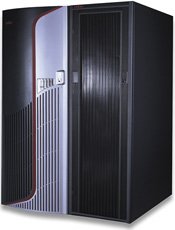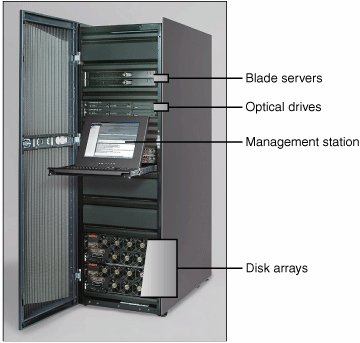Chapter 16. Server Racks and Blades
| As an organization grows, the size and the number of servers it deploys grows as well. Some applications lend themselves to deployment on larger and larger servers, while other environments benefit from the deployment of larger numbers of servers. You scale up to larger systems when processing is the main consideration, as might be the case with an enterprise database server, such as DB2, Oracle, or SQL Server. You scale out when the primary consideration is the amount of I/O you can supply. Examples of applications that benefit from scaling out are the server farms you see deployed in webservers, such as Apache, Microsoft IIS, iPlanet, and Zeus. If you are situating a large multiprocessor server, such as a Unisys ES7000 Orion 560 (shown in Figure 16.1), you can simply roll that server into a secure room that has the right cooling, the correct power hookup, raised flooring, and humidity (or environmental) control, and you are set. The Orion 560 is a 32 Itanium processor system that has physical dimensions of 49 inches wide by 48 inches deep by 69 inches tall, which is a double-rack construction. What might not be obvious from Figure 16.1, but would be if the doors were open, is that systems like this one are constructed around racks with components that fit into those racks. Figure 16.1. The Unisys ES7000 Orion 560 is an example of a large server system where the rack construction is hidden by a shell.Image courtesy of Unisys Corporation. You can see the rack construction in another Unisys product, the Clear Path Plus Libra 590 server, which is a single-rack system. When you open the Libra's door, you see that this server is a single-rack system with a number of components bolted into it. The system dimensions are 22 inches wide by 47 inches deep by 69 inches tall. On the bottom are a couple 2U disk arrays, in the middle is a management station (laptop) with a KVM switch, above that are a couple optical drives, and at the top are some multiprocessor chassis that take blade servers, as shown in Figure 16.2. (Later in this chapter, in the section "Universal Racks," you'll learn what the term U, as in 2U, means and how that translates into the racks you can purchase for yourself.) For now, though, it suffices to say that 1U is the vertical dimension of the smallest-sized chassis that can be bolted onto a universal rack and that large-sized chassis are simply multiples of this height. A 1U height is roughly the height of a standard audiophile's hi-fi receiver. Figure 16.2. The Clear Path Plus Libra 590 is shown here with the front door open. The Libra 590 demonstrates many of the features of server rack construction that are discussed in this chapter. Its standard-size rack takes standard-size components, allowing you to mix and match parts to build the server you need. The Libra 590 can take up to 56 processors, arranged in 8-processor units, where each processor is a blade in the chassis. Blade servers will play an increasingly prominent role in server architectures in the future, and you will learn later in this chapter about the advantages blades can offer. Because it can have up to 56 processors, a system such as the 590 lets you run multiple-server systems within the same rack, each with its own operating system. Because you need a way to manage all these servers without having to have multiple monitors, mouse devices, and keyboards hanging off the rack, any multiserver deployment requires the use of a KVM switch to control all the servers. A KVM switch takes the place of multiple keyboards, video displays, and mouse devices, switching from one computer system to another so that you can use a single keyboard, monitor, and mouse to control any number of systems. You might think that rack mounting is something only for data centers, but that is not the case. Racks are available at moderate cost for small and medium-sized businesses. You can purchase a simple open rack for as little as $175, with the more professional models costing from $1,000 to $1,500. Racks and casings such as the ones shown here typically cost around $3,500 to purchase in one-off quantity. There are many good reasons for setting up a rack-based server system. Here are some of the most common reasons:
|
EAN: 2147483647
Pages: 240

